Introduction
Cotton is highly accessible to the improvement of genotypes as varieties with the huge amenability for exploitation of heterosis at commercial scale. Therefore, utilization of hybrids is one of the means for improvement of the yield and other yield contributing traits in cotton. Heterosis is a fundamental tool in development of any crop in the form of F1 generation which provides knowledge about the desirable parental combinations in any breeding programmes.1 World’s first hybrid H4 is the fabulous example for successful utilization of hybrid vigor on commercial scale.
Many researchers reported hybrid vigor for yield and yield contributing characters in intra-hirsutum cotton hybrids.1,2,3 The significant heterosis for seed cotton yield and yield attributing traits like number of sympodia, number of bolls per plant and boll weight is desirable in upland cotton.2,3 Albeit the release of numerous hybrids during last decade has increased the productivity of cotton, the yields of hybrids however appear to have reached stagnation.2,3 This might be due to lack in identification or development of specific combiners for important yield contributing characters in hybrid populations and use of less diversified genotypes in hybridization programme. Therefore, for commercial exploitation of heterosis in cotton, pre-requisites are identification of parents which show good heterosis on crossing and production of high yielding hybrids.
Ratooning ability of cotton is the ability to maintain seed yield and fibre qualities as the ratoon crops increases. The primary application of cotton ratooning is the achievement of high seed yield, in order to minimize the cost burden on the procurement of seed material. The costs of growing a ratoon crop of cotton are less than the costs of growing a first crop and also the time required for flowering is less in ratoon crop than the first crop.4 The major reasons for the decline in yield of the ratoon crops are genotypic and morphological differences in varieties which act either singly or in combination.4 A variety can be considered to have the good ratooning ability when it can maintain the yield similar to the first crop.4
Owing to the paramount significance of heterosis and ratooning in the development of high yielding cotton hybrids, the present study was undertaken in line x tester design using 4 lines, 7 testers and their resultant 28 hybrids to identify best performing cross combinations with an objective to estimate ratooning ability and heterosis. The heterotic effects such as relative heterosis, heterobeltiosis and standard heterosis were estimated in order to evaluate the genetic potential and variability present in the parents and hybrids for various yield contributing characters.
Materials and Methods
Genetic Materials
Four cultivated varieties of Gossypium hirsutum viz., TSH 0499, TSH 04/115, BGDS 1063 and ARBC 19 and seven cultivated varieties of Gossypium hirsutum viz., SURABHI, SVPR 4, TCH 1705-101, TCH 1777, TCH 1819, TSH 0250 and VS 9-S11-1. These cultivars were cultivated in southern states of India, and collected from the Department of Cotton, Tamil Nadu Agricultural University (TNAU), Coimbatore, Tamil Nadu, India.
Experimental Design and Field Procedures
A field experiment was conducted to evaluate the Mean performance and ratooning ability for yield and yield contributing traits. The cotton cultivars were evaluated in a randomized block design (RBD) with two replications at Department of Cotton, TNAU, Coimbatore, India. The twenty eight hybrids was grown with a spacing of 90 x 60 cm during Rabi 2016 – 17 and considered that crop as first crop. The first crop was pruned with garden shears (Gowmathi Agro Instruments Pvt Ltd. India) at a height of 30 cm above ground level. Weak and dried shoots were thinned out from the pruned stumps and then earthed up and considered as a ratoon crop and allowed to grow during Kharif 2017. The plant protection measures taken for the ratoon crops was similar to the first crop.
Sampling, Traits Measurements and Data Analysis
Data were recorded on five unbiasedly selected plants per replication for all the characters viz., days to first flowering (DFF), plant height (PH), number of monopodial branches per plant (NM), number of sympodial branches per plant (NS), number of bolls per plant (NB), Boll weight (BW), Seed cotton yield per plant (SCY), lint index (LI), seed index (SI) and ginning out turn (GOT). The means for all the observed parameters were worked out and further subjected to analysis of variance and heterosis from the replicated data worked out using the AGRISTAT statistical analysis software (TNAU Coimbatore).
Calculation of Ratooning Ability
Ratooning ability (RA) is defined as RAi = 100 RCi / FCi. The RA of trait ‘i’ is defined as the ratio of the ratoon crop (RC) yield for trait ‘i’ to the first crop yield (FC) for trait ‘i’ and expressed as a percentage. A modified form of sugarcane ratooning ability equation was applied to cotton, because here, cotton was allowed for a single ratoon crop, unlike sugarcane. Therefore, the second ratoon (SR) present in the sugarcane ratooning ability equation is replaced by ratoon crop (RC) of cotton to calculate the cotton ratooning ability.4
Results and Discussion
Analysis of Variance
Analysis of variance for randomized block design was carried out to evaluate the significant differences among the genotypes in first crop and ratoon crop. Results suggested that the existence of considerable genetic variation in all yield and yield contributing traits. The significant variation was observed for all the traits excluding the traits namely number of monopodial branches per plant and boll weight (Table 1). Similar results were reported by Ranganatha et al., (2013).5
Table 1: Analysis of variance for yield and yield contributing traits among parents and crosses in first and ratoon crop.
|
Source |
Mean squares |
||||||||||
|
df |
DFF |
PH |
NM |
NS |
NB |
BW |
SCY |
SI |
LI |
GOT |
|
| Replication | 1 |
5.25 (0.75) |
1.00 (7.42) |
0.44 (0.19) |
1.48 (3.52) |
74.01 (3.09) |
0.01 (1.06) |
279.21 (22.32) |
0.01 (0.90) |
0.02 (0.04) |
0.35 (3.50) |
| Genotypes | 38 |
9.49** (3.71**) |
242.26** (223.07**) |
0.58 (0.43) |
15.69** (4.15**) |
81.51** (12.51**) |
0.55 (0.34) |
2287.24** (185.77**) |
3.34** (7.12**) |
1.05* (0.66) |
7.98** (5.55**) |
| Parents | 10 |
7.63** (3.27**) |
119.69** (80.32**) |
0.73 (0.74) |
9.98** (4.41**) |
46.08** (4.76**) |
0.54 (0.16) |
712.24** (152.43**) |
2.52* (2.42*) |
0.98* (0.87*) |
6.86** (1.75*) |
| Lines | 3 |
6.48** (2.27*) |
202.86** (1188.40**) |
1.12 (0.62) |
4.01* (18.06**) |
39.06** (75.63**) |
0.23 (1.23) |
595.59* (299.44**) |
2.71* (26.48**) |
1.11* (1.16*) |
1.15* (0.56) |
| Testers | 6 |
8.94** (4.21*) |
100.67** (50.44**) |
0.62 (0.28) |
5.61** (3.18*) |
16.99* (5.49*) |
0.71 (0.17) |
561.82** (297.85**) |
1.54* (4.26*) |
0.65* (0.21) |
9.88** (9.72**) |
| Lines vs Testers | 1 |
1.87 (3.06*) |
3.36 (333.24**) |
0.33 (1.26) |
58.52** (0.27) |
270.75** (0.38) |
0.31 (0.08) |
2115.11** (144.92**) |
8.83** (16.10**) |
2.88* (6.73**) |
2.91* (0.73) |
| Crosses | 27 |
9.82** (3.67**) |
285.11** (244.26**) |
0.47 (0.30) |
14.90** (3.78**) |
82.68** (15.72**) |
0.51 (0.42) |
2720.50** (202.82**) |
3.34** (8.48**) |
1.07* (0.57*) |
8.52** (6.80**) |
| Cross vs Parents | 1 |
19.62** (9.09*) |
262.23** (1078.22**) |
2.18 (0.77) |
102.95** (11.52*) |
435.00** (3.34) |
1.97 (0.01) |
6181.34** (58.94**) |
12.18** (17.12**) |
1.21* (1.23) |
3.76 (9.85*) |
| Error | 38 |
1.05 (0.84) |
7.67 (23.63) |
0.13 (0.05) |
2.24 (2.23) |
3.90 (2.15) |
0.07 (0.19) |
79.52 (107.93) |
0.07 (0.67) |
0.04 (0.27) |
2.03 (1.20) |
* and **: significance at p ≤ 0.05 and p ≤ 0.01 respectively, df: Degrees of freedom, DFF: Days to first flowering, PH: Plant height (cm), NM: Number of monopodial branches per plant, NS: Number of sympodial branches per plant, NB: Number of bolls per plant, BW: Boll weight (g), SCY: Seed cotton yield per plant (g), SI: Seed index, LI: Lint index, GOT: Ginning out turn (%).
Mean Performance and Ratooning Ability of Parents
Improvement of yield and other advantageous traits involves selection of parents which is considered as the crucial objective in any of the breeding programme. Information on per se performance of characters is necessary for selection of parents for developing hybrids. Parents expressed significant differences for the number of bolls per plant, boll weight, lint index and seed cotton yield per plant in both first crop and ratoon crop. Among the parents, TSH 0499 and TSH 04/115 parents recorded the highest mean performance and remaining parents showed the lowest mean performance for number of bolls per plant, boll weight, lint index and seed cotton yield per plant in both first crop and ratoon crop. In case of ratooning ability, SURABHI, TSH 0250 and VS 9-S11-1 parents expressed highest ratooning ability and remaining parents documented lowest ratooning ability for investigated traits (Table 2).
Table 2: Mean performance and ratooning ability of parents for yield and yield contributing traits.
| Parents |
Number of bolls per plant |
Boll weight (g) |
Lint index |
Seed cotton yield per plant (g) |
||||||||
| FC | RC | RA% | FC | RC | RA% | FC | RC | RA% | FC | RC | RA% | |
| Lines | ||||||||||||
| TSH 0499 | 39.50* | 16.66 | 42.17 | 5.40* | 3.90* | 72.22 | 7.68* | 6.04* | 78.65 | 145.45* | 111.00* | 76.31 |
| TSH 04/115 | 39.15* | 14.67 | 37.47 | 5.65* | 3.30 | 58.41 | 6.10 | 5.54 | 90.82 | 155.00* | 110.34 | 71.19 |
| BGDS 1063 | 35.35* | 13.63 | 38.56 | 4.10 | 3.10 | 75.61 | 6.18 | 5.04 | 81.55 | 152.68* | 100.56 | 65.86 |
| ARBC 19 | 30.00 | 13.34 | 44.47 | 4.80 | 3.00 | 62.50 | 7.00* | 5.22 | 74.57 | 117.50 | 101.23 | 86.15 |
| Mean | 36.00 | 14.36 | 40.11 | 4.99 | 3.33 | 67.18 | 6.74 | 5.46 | 81.40 | 142.66 | 105.78 | 74.88 |
| Testers | ||||||||||||
| SURABHI | 22.20 | 15.52 | 69.91 | 5.00 | 3.40 | 68.00 | 5.72 | 4.77 | 83.39 | 106.50 | 98.67 | 92.65 |
| SVPR 4 | 28.10 | 15.93 | 56.69 | 4.60 | 3.20 | 69.57 | 5.83 | 4.89 | 83.88 | 129.54 | 103.45 | 79.86 |
| TCH 1705-101 | 25.40 | 14.03 | 55.24 | 3.66 | 2.90 | 79.23 | 5.55 | 4.68 | 84.32 | 99.89 | 90.59 | 90.69 |
| TCH 1777 | 32.80 | 16.66 | 50.79 | 3.70 | 3.01 | 81.35 | 6.21 | 4.90 | 78.90 | 132.53 | 109.68 | 82.76 |
| TCH 1819 | 29.20 | 16.02 | 54.86 | 4.55 | 3.06 | 67.25 | 6.23 | 5.33 | 85.55 | 105.85 | 99.93 | 94.41 |
| TSH 0250 | 21.00 | 13.54 | 64.48 | 3.41 | 2.89 | 84.75 | 4.99 | 4.83 | 96.79 | 98.77 | 94.89 | 96.07 |
| VS 9-S11-1 | 20.00 | 12.56 | 62.80 | 4.42 | 3.04 | 68.78 | 5.65 | 5.00 | 88.50 | 100.71 | 99.01 | 98.31 |
| Mean | 25.53 | 14.89 | 59.25 | 4.19 | 3.07 | 74.13 | 5.74 | 4.91 | 85.91 | 110.54 | 99.46 | 90.68 |
| GRAND MEAN | 30.76 | 14.62 | 49.68 | 4.58 | 3.19 | 70.65 | 6.24 | 5.18 | 83.64 | 126.59 | 102.62 | 82.77 |
| SEd | 2.07 | 1.59 | 0.49 | 0.41 | 0.57 | 0.42 | 16.11 | 10.10 | ||||
| CD (0.05) | 5.26 | 2.90 | 0.80 | 0.84 | 1.91 | 1.00 | 33.13 | 20.64 | ||||
| CV % | 8.64 | 10.81 | 10.05 | 14.79 | 8.40 | 9.63 | 12.66 | 13.48 | ||||
* and **: significance at p ≤ 0.05 and p ≤ 0.01 respectively, FC: First crop, RC: Ratoon crop, RA%: Ratooning ability.
Mean Performance and Ratooning Ability of Intra-hirsutum Hybrids
The mean performance is the primary criterion to evaluate the value of a hybrid and it is a useful index for judging the potential of hybrids.6,7 Promising hybrids displayed significant differences in the number of bolls per plant, boll weight, lint index and seed cotton yield per plant in both first crop and ratoon crop. The results show that the hybrids ARBC 19 x TCH 1705-101 and TSH 0499 x TCH 1777 recorded minimum (22.17 and 10.34 %) and maximum (50.15 and 19.45 %) values for the number of bolls per plant in first crop and ratoon crop. Overall, nine hybrids in first crop and nine hybrids in ratoon crop were significant over mean value. Among the twenty eight hybrids, the hybrid ARBC 19 x TSH 0250 displayed the highest ratooning ability (65.20 %) and TSH 0499 x SURABHI expressed the lowest ratooning ability (29.42 %) (Table 3).
Table 3: Mean performance and ratooning ability of hybrids for yield and yield contributing traits.
| Parents |
Number of bolls per plant |
Boll weight (g) |
Lint index |
Seed cotton yield per plant (g) |
||||||||
| FC | RC | RA% | FC | RC | RA% | FC | RC | RA% | FC | RC | RA% | |
| TSH 0499 x SURABHI | 41.95* | 12.34 | 29.42 | 3.95 | 3.89* | 98.48 | 6.75 | 5.59 | 82.81 | 125.62 | 99.62* | 79.30 |
| TSH 0499 x SVPR 4 | 39.90* | 13.35 | 33.46 | 5.55* | 3.10 | 55.86 | 6.43 | 5.68 | 88.34 | 202.90* | 95.83* | 47.23 |
| TSH 0499 x TCH 1705-101 | 35.41 | 12.57 | 35.50 | 3.45 | 3.35 | 97.10 | 6.12 | 5.56 | 90.85 | 110.21 | 99.90* | 90.65 |
| TSH 0499 x TCH 1777 | 50.15* | 19.45* | 38.78 | 5.80* | 3.32 | 57.24 | 5.90 | 5.40 | 91.53 | 188.05* | 89.37 | 47.52 |
| TSH 0499 x TCH 1819 | 42.50* | 18.47* | 43.46 | 5.55* | 3.45 | 62.16 | 7.75* | 6.24* | 80.52 | 212.70* | 87.21 | 41.00 |
| TSH 0499 x TSH 0250 | 36.89 | 18.47* | 50.07 | 3.85 | 3.12 | 81.04 | 6.12 | 6.04* | 98.69 | 110.00 | 88.82 | 80.75 |
| TSH 0499 x VS 9-S11-1 | 40.79* | 14.35 | 35.18 | 4.10 | 3.80* | 92.68 | 6.99* | 6.00* | 85.84 | 129.17 | 89.05 | 68.94 |
| TSH 04/115 x SURABHI | 41.00* | 15.35 | 37.44 | 4.50 | 3.13 | 69.56 | 7.27* | 6.10* | 83.91 | 171.85* | 96.82 | 56.34 |
| TSH 04/115 x SVPR 4 | 38.80* | 16.47* | 42.45 | 4.60 | 3.55 | 77.17 | 7.25* | 6.00* | 82.76 | 227.50* | 77.70 | 34.15 |
| TSH 04/115 x TCH 1705-101 | 35.81 | 17.58* | 49.09 | 3.89 | 3.24 | 83.29 | 6.12 | 5.99* | 97.88 | 110.12 | 76.87 | 69.81 |
| TSH 04/115 x TCH 1777 | 43.15* | 18.36* | 42.55 | 5.10* | 3.85* | 75.49 | 6.50 | 5.34 | 82.15 | 166.61* | 78.00 | 46.82 |
| TSH 04/115 x TCH 1819 | 40.70* | 14.36 | 35.28 | 5.05* | 3.81* | 75.45 | 7.07* | 6.10* | 86.28 | 192.98* | 78.90 | 40.89 |
| TSH 04/115 x TSH 0250 | 36.71 | 13.47 | 36.69 | 3.91 | 3.10 | 79.28 | 6.43 | 5.36 | 83.36 | 120.12 | 83.74 | 69.71 |
| TSH 04/115 x VS 9-S11-1 | 37.97 | 14.36 | 37.82 | 4.17 | 3.80* | 91.13 | 6.45 | 5.37 | 83.26 | 145.92 | 85.43 | 58.55 |
| BGDS 1063 x SURABHI | 33.20 | 14.56 | 43.86 | 3.45 | 3.10 | 89.86 | 6.25 | 5.83 | 93.28 | 110.42 | 81.85 | 74.13 |
| BGDS 1063 x SVPR 4 | 30.70 | 16.46* | 53.62 | 4.45 | 3.12 | 70.11 | 5.35 | 4.90 | 91.59 | 171.85* | 87.84 | 51.11 |
| BGDS 1063 x TCH 1705-101 | 31.21 | 14.35 | 45.98 | 3.12 | 2.5 | 80.13 | 5.21 | 4.80 | 92.13 | 98.45 | 77.50 | 78.72 |
| BGDS 1063 x TCH 1777 | 35.80 | 16.46* | 45.98 | 4.55 | 3.12 | 68.57 | 6.84 | 4.90 | 71.64 | 98.17 | 68.84 | 70.12 |
| BGDS 1063 x TCH 1819 | 32.50 | 16.36* | 50.34 | 6.10* | 3.45 | 56.56 | 6.11 | 4.90 | 80.20 | 163.65* | 69.12 | 42.24 |
| BGDS 1063 x TSH 0250 | 30.19 | 14.35 | 47.53 | 3.15 | 3.00 | 95.24 | 5.24 | 4.80 | 91.60 | 155.60 | 70.84 | 45.53 |
| BGDS 1063 x VS 9-S11-1 | 33.21 | 13.45 | 40.50 | 3.99 | 3.80* | 95.24 | 6.26 | 4.70 | 75.08 | 99.16 | 72.64 | 73.26 |
| ARBC 19 x SURABHI | 26.60 | 12.45 | 46.80 | 4.30 | 3.55 | 82.56 | 7.01* | 5.03 | 71.75 | 125.19 | 75.34 | 60.18 |
| ARBC 19 x SVPR 4 | 31.00 | 11.34 | 36.58 | 4.30 | 3.00 | 69.77 | 6.50 | 5.47 | 84.15 | 105.10 | 76.98 | 73.24 |
| ARBC 19 x TCH 1705-101 | 22.17 | 10.34 | 46.64 | 3.45 | 2.85 | 82.61 | 6.44 | 5.46 | 84.78 | 117.80 | 68.71 | 58.33 |
| ARBC 19 x TCH 1777 | 30.90 | 14.35 | 46.44 | 4.60 | 3.21 | 69.78 | 5.60 | 5.39 | 96.25 | 109.11 | 69.12 | 63.35 |
| ARBC 19 x TCH 1819 | 30.30 | 13.67 | 45.12 | 5.05* | 2.10 | 41.58 | 6.61 | 5.47 | 82.75 | 130.40 | 70.92 | 54.39 |
| ARBC 19 x TSH 0250 | 23.71 | 15.46 | 65.20 | 3.52 | 2.80 | 79.55 | 6.59 | 5.55 | 84.22 | 139.30 | 70.42 | 50.55 |
| ARBC 19 x VS 9-S11-1 | 30.12 | 13.24 | 43.96 | 4.57 | 3.00 | 65.65 | 6.17 | 5.26 | 85.25 | 105.19 | 71.85 | 68.30 |
| MEAN | 35.12 | 14.85 | 43.15 | 4.36 | 3.33 | 78.88 | 6.40 | 5.47 | 85.82 | 140.83 | 79.23 | 59.69 |
| BUNNY (Check) | 29.90 | 16.78 | 56.12 | 3.75 | 2.30 | 61.33 | 6.14 | 4.26 | 69.38 | 129.05 | 85.23 | 66.04 |
| SEd | 2.89 | 1.46 | 0.43 | 0.44 | 0.52 | 0.49 | 16.96 | 10.38 | ||||
| CD (0.05) | 5.81 | 2.94 | 0.87 | 0.88 | 1.05 | 1.00 | 34.09 | 20.88 | ||||
| CV % | 8.77 | 10.96 | 10.14 | 14.17 | 8.48 | 9.98 | 12.94 | 13.05 | ||||
* and **: significance at p ≤ 0.05 and p ≤ 0.01 respectively, FC: First crop, RC: Ratoon crop, RA%: Ratooning ability
Boll weight in first crop ranged from 3.12 g (BGDS 1063 x TCH 1705-101) to 6.10 g (BGDS 1063 x TCH 1819), whereas in ratoon crop the minimum and maximum values recorded were 2.10 g in ARBC 19 x TCH 1819 and 3.89 g in TSH 0499 x SURABHI. Seven hybrids in first crop and seven hybrids in ratoon crop revealed significant higher boll weight than overall mean value. The same hybrid TSH 0499 x SURABHI (98.48 %) was showed the highest ratooning ability and the same hybrid ARBC 19 x TCH 1819 (41.58 %) displayed the lowest ratooning ability (Table 3). In first crop the hybrids BGDS 1063 x TCH 1705-101 and TSH 0499 x TCH 1819 recorded the minimum and maximum lint index of 5.21 to 7.75, respectively and where as in ratoon crop the same hybrid TSH 0499 x TCH 1819 (6.24) recorded the highest lint index and BGDS 1063 x VS 9-S11-1 (4.70) displayed the least lint index. Six hybrids in first crop and seven hybrids in ratoon crop showed significantly superior lint index to the overall mean. The hybrid BGDS 1063 x TCH 1777 (71.64 %) documented the lowest ratooning ability and TSH 0499 x TSH 0250 (98.69 %) showed the highest ratooning ability (Table 3).
Seed cotton yield per plant in the first crop was ranged from 98.17 g (BGDS 1063 x TCH 1777) to 227.50 g (TSH 04/115 x SVPR 4). In case of ratoon crop, the cross combinations BGDS 1063 x TCH 1705-101 and TSH 0499 x TCH 1705-101 exhibited the lowest (68.71 g) and the highest (99.90 g) values for the same trait. Nine hybrids in first crop and three hybrids in ratoon crop documented significant higher seed cotton yield over mean value. The ratooning ability was ranged from 34.15 % (TSH 04/115 x SVPR 4) to 90.65 % (TSH 0499 x TCH 1705-101) (Table 3). The results indicating that the highest ratooning ability was due to the superiority expression of the traits in ratoon crop, while lowest ratooning ability was due to a high reduction of the yield in the traits of ratoon crop.4 Generally, the changes in ratooning ability and ratoon crop yields are not necessarily to be correlated.8,9 Cotton yield and all of its attributes were significantly affected by crop age.4,8 The genotype by crop age interaction was significant for all studied traits, indicating that hybrid performance differed among the crop cycles. Various studies reported that genotype by crop interaction was important for yield and its contributing traits.10,11,12 The evaluated genotypes significantly differed in their ratooning ability for all studied traits and a similar phenomenon has been reported for sugarcane ratooning.4,13
Relative Heterosis in Intra-Hirsutum Hybrids
In first crop, the highest positive relative heterosis was observed for SI (112 % in TSH 04/115 x TSH 0250) while the DFF recorded the lowest value (3.17 % in TSH 0499 x TCH 1777) (Fig.1). Nonetheless, the negative relative heterosis was also observed for all the tested traits except for NS. The maximum negative relative heterosis was detected for NM (-47.37 % in BGDS 1063 x TCH 1777) whereas the SI documented the least negative relative heterosis (-5.37 % in BGDS 1063 x TCH 1705-101) (Fig. 1). In case of ratoon crop, the highest positive relative heterosis was detected for PH (70 % in TSH 04/115 x SURABHI) while the traits DFF and GOT recorded the lowest values (~3.5 % in TSH 0499 x TSH0250 and TSH 0499 x TCH 1819) (Fig. 2). Conversely, the negative relative heterosis was also observed for all the tested traits. The maximum negative relative heterosis was detected for NM (-47 % in BGDS 1063 x TCH 1777) whereas the DFF recorded the lowest negative relative heterosis (-5.23 % in BGDS 1063 x SURABHI) (Fig. 2).
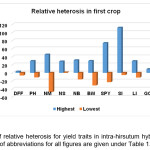 |
Figure 1: Range of relative heterosis for yield traits in intra-hirsutum hybrids in first crop. The expansions of abbreviations for all figures are given under Table 1. |
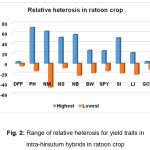 |
Figure 2: Range of relative heterosis for yield traits in intra-hirsutum hybrids in ratoon crop. |
Heterobeltiosis in Intra-Hirsutum Hybrids
The maximum positive heterobeltiosis was observed for SI (70 % in TSH 04/115 x TSH 0250) whereas the traits DFF and NS recorded the lowest values (~3.5 % in BGDS 1063 x SVPR 4 and BGDS 1063 x TCH 1899) in first crop (Fig. 3). However, the trait LI did not show positive heterobeltiosis at all. On the other hand, all the tested traits were showed negative heterobeltiosis. The maximum negative heterobeltiosis was detected for NM (-42.63 % in TSH 0499 x TCH 1819) whereas the traits DFF and GOT documented the least negative heterobeltiosis values (appox. -6 % in ARBC 19 x TSH 0250) (Fig. 3). In case of ratoon crop, the highest positive heterobeltiosis was detected for PH (60.75 % in TSH 04/115 x SURABHI) while the traits DFF recorded the lowest value (-5.13 % in ARBC19 x TCH 1777) (Fig. 4). Conversely, the negative heterobeltiosis was also observed for all the tested traits. The maximum negative heterobeltiosis was detected for NM (-47.08 % in TSH 0499 x TSH 0250) which can contribute to high yields. Whereas the DFF recorded the lowest negative heterobeltiosis (-5.87 % in ARBC 19 x TSH 0250) (Fig. 4).
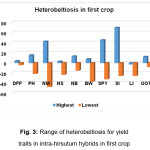 |
Figure 3: Range of heterobeltiosis for yield traits in intra-hirsutum hybrids in first crop. |
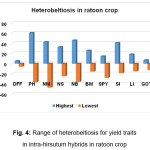 |
Figure 4: Range of heterobeltiosis for yield traits in intra-hirsutum hybrids in ratoon crop. |
Standard Heterosis in Intra-Hirsutum Hybrids
The highest positive standard heterosis was observed for PH (61.71 % in TSH 0499 x SVPR 4) although the DFF and GOT recorded the lowest values (~3 % in TSH 0499 x TCH 1819 and ARBC x TSH 0250) in first crop (Fig. 5). Conversely, the negative standard heterosis was also observed for all the tested traits. The maximum negative standard heterosis was detected for SI and LI (approx. -30 % in BGDS 1063 x VS 9-S11-1 and BGDS 1063 x SVPR 4) whereas the traits DFF, NM and SCY documented the least negative standard heterosis values (approx. -8 % in ARBC x SURABHI, BGDS x TCH 18 19 and ARBC x TSH 0250) (Fig. 5). In case of ratoon crop, the highest positive standard heterosis was detected for SCY (68.86 % in TSH 04/115 x SVPR 4) while the traits DFF and GOT recorded the lowest values (~5.5 % in BGDS x TSH 0250 and ARBC x SURABHI) (Fig. 6). Nevertheless, the negative standard heterosis was also observed for all the tested traits except for NB. The maximum negative standard heterosis was detected for NM (-50.74 % in BGDS 1063 x VS 9-S11-1) while the DFF recorded the lowest negligible negative standard heterosis (-0.02 % in BGDS x VS 9-S11-1) (Fig. 6). All the hybrids recorded a range of significantly positive and negative heterosis for different traits. Several researchers have reported the significant heterosis for boll weight and GOT, Seed index, lint index.14,15,16 However, negative heterosis is desirable for seed index since the hybrids produce more lint.16
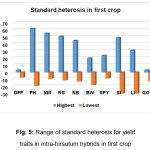 |
Figure 5: Range of standard heterosis for yield traits in intra-hirsutum hybrids in first crop. |
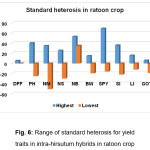 |
Figure 6: Range of standard heterosis for yield traits in intra-hirsutum hybrids in ratoon crop. |
Conclusion
The present study demonstrated that the hybrids are superior to the parents for all the investigated traits. Among the parents, TSH 0499 and TSH 04/115 parents showed a fair performance for yield and yield contributing traits and SURABHI, TSH 0250 and VS 9-S11-1 parents expressed superior ratooning ability. Therefore, these parents have a potential to be exploited for the development of the efficient cotton hybrids. Among the tested F1 hybrids, TSH 0499 x TCH 1777, BGDS 1063 x TCH 1819, TSH 0499 x TCH 1819 and TSH 04/115 x SVPR 4 hybrids documented superior performance for number of bolls, boll weight, lint index and seed cotton yield in first crop, respectively. ARBC 19 x TSH 0250, TSH 0499 x SURABHI, TSH 0499 x TSH 0250 and TSH 0499 x TCH 1705-101 cross combinations exhibited good ratooning ability performance for number of bolls, boll weight, lint index and seed cotton yield, respectively. All the hybrids exhibited a range of significantly positive and negative heterosis for different traits. However, negative heterosis is desirable for seed index since the hybrids produce more lint. The results of this study would provide insights into the understanding of genetic variance present in various intraspecific cotton hybrids.
Acknowledgements
Authors acknowledge the Department of Cotton, Centre for Plant Breeding and Genetics, TNAU, Coimbatore, India for providing all research facilities.
References
- Khan, U. Q. Studies of heterosis in fibre quality traits of upland cotton. Asian J. Plant Sci. 2002;1(5):593-595.
- Solanki, H. V., Mehta, D. R., Rathod, V. B. and Valu, M. G. Heterosis for seed cotton yield and its contributing character in cotton (Gossypium hirsutum L.). Electronic J. Plant Breed. 2014;5(1):124-130.
- Shah, K. A., Khan, N. U., Shah, L., Ali, A., Khan, A., Ying, X. and Abbas, Z. Heterotic studies in 8 × 8 diallel crosses of upland cotton. Academic Res. J. Agric. Sci. Res. 2015;3(6):128-136
- Milligan, S.B., Gravois, K.A. and Martin, F.A. Inheritance of sugarcane ratooning ability and relationship of younger crop traits to older crop traits. Crop Sci. 1996;36: 45–50.
- Ranganatha, H., Patil, S., Manjula, S. and Patil, B. Studies on heterosis in cotton (Gossypium hirsutum L.) for seed cotton yield and its components. Asian J. Plant Sci. 2013;8:82–85.
- Kadambavanasundaram, M. Combining ability as related to gene action in cotton (Gossypium hirsutum L.). Ph.D. Thesis, Tamil Nadu Agricultural University, TN, Coimbatore, India. 1980.
- Nadarajan, N. Genetic analysis of fibre characters in cotton (Gossypium hirsutm L.). Ph.D. Thesis, Tamil Nadu Agricultural University, Coimbatore, TN, India. 1986.
- Chapman, L.S., Ferraris, R. and Ludlow, M.M. Constraints to production in ratoon crops. Proc. Australian Soc. Sugar Cane Technol. 1992;14:130–138.
- Masri, M.I. and Amein, M.M.M. Trait relationships in sugarcane at final selection stages. J. Plant Breed. Crop Sci. 2015;7:262–274.
- Milligan, S.B., Gravois, K.A., Bischoff, K.P. and Martin, F.A. Crop effects on broad–Sense heritability and genetic variances of sugarcane yield component. Crop Sci. 1990;30:344–349.
- Orgeron, A.J., Gravois, K.A. and Bischoff, K.P. Planting rate effects on sugarcane yield trials. J. Am. Soc. Technol. 2007;27:23–34.
- EL-Hinnawy, H.H. and Masri, M.I. Ratooning ability and indirect response to selection in sugarcane. J. Agric. Sci. Mansoura Univ. 2009;34:6755–6767.
- Olaoye, G. Estimate of ratooning ability in sugarcane (Saccharum officinarum L) under conditions of low-available soil moisture in a savanna ecology of Nigeria. Moor J. Agric. Res. 2005;6:16–23.
- Rauf, S., Khan, T.M. and Nazir, S. Combining ability and heterosis in Gossypium hirsutum L. Int. J. Agric. Biol. 2005;7:109-113.
- Karande, S.S., Wandhare, M.R., Ladole, M.Y. and Waode, M.M. Heterosis and combining ability studies in interspecifc diploid cotton hybrids for fiber quality parameters. International Symposium on strategies for sustainable cotton production, A Global Vision. University of Agriculture Sciences, Dharwad, Karnataka, India. 2004;23-25.
- Geddam, S.B., Khadi, B.M., Mogali, S. and Patil R.S. Study of heterosis in genetic male sterility based diploid cotton hybrids for yield, yield component and fibre quality characters. Karnataka J. Agric. Sci. 201124:118-124.

